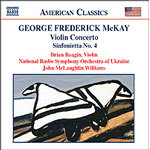
Violin Concerto / Sinfonietta No. 4 / Song Over the Great Plains
 $25.00
Out of Stock
$25.00
Out of Stock6+ weeks add to cart
GEORGE FREDERICK McKAY
Violin Concerto / Sinfonietta No. 4 / Song Over the Great Plains
Ludmilla Kovaleva, piano / Brian Reagin, violin / Ukraine National Radio Symphony Orchestra / John McLaughlin Williams, conductor
[ Naxos American Classics / CD ]
Release Date: Wednesday 23 February 2005
This item is currently out of stock. It may take 6 or more weeks to obtain from when you place your order as this is a specialist product.
"Naxos's third McKay disc ... a worthy revival of music that could otherwise have been lost to posterity"
- MusicWeb Feb 2005
George Frederick McKay, known as the Dean of Northwest Composers and revered Professor of Music at the University of Washington for 41 years, from 1927 to 1968, was born to a pioneering family in the small wheat-farming community of Harrington, Washington on 11th June, 1899. He spent most of his childhood in Spokane where his father worked as a farmland surveyor for a local bank, and began composing orchestral music as early as his high school years. His father did not approve of a career in music, and he was encouraged to enroll at Washington State College at Pullman to earn a business degree. In 1919, weary of this, he transferred to the University of Washington, Seattle, where he began seriously studying music and composition with Carl Paige Wood. Two years later a scholarship allowed him to study composition with Christian Sinding and Selim Palmgren at the Eastman School of Music at Rochester, New York, earning the first composition degree awarded there. His first published compositions were written and published during this time.
After his graduation from Eastman in 1923, McKay embarked on a teaching career that included posts in North Carolina, South Dakota, and Missouri and finally at what became his permanent professorship at the University of Washington, Seattle. There he became recognized over the span of four decades as an outstanding teacher, composer and leader in the propagation of American music. His works were widely performed and broadcast under some of the most distinguished conductors. He was the recipient of many honours during his lifetime, including his twice holding the Alchin Chair at the University of Southern California (1938-39). He received important commissions from national orchestras, and was awarded national prizes for harp, woodwind, piano, organ and symphonic compositions. McKay was equally successful as a teacher, with students including William Bolcom, Earl Robinson, John Cage and Goddard Lieberson. He died in 1970 at his home in Lake Tahoe, Nevada.
In 1941 George Frederick McKay entered his recently composed Violin Concerto in the Heifetz Competition, newly established by Jascha Heifetz and the music publisher Carl Fischer. By 1940, when he wrote his Violin Concerto, McKay was an established composer who could point to many performances and broadcasts by some of the great musicians of the day. His position at the University of Washington in Seattle, however, far removed from the musical centres of the northeast, meant that he was still seen as an artist of largely local significance. McKay, like other competitors, hoped that success would give his work the kind of broad national exposure that only a world famous artist could give it. Though McKay's work received an honourable mention and was praised by Heifetz, it failed to capture the top prize, which went to Gail Kubik's Violin Concerto No. 2. McKay's concerto shares strong formal affinities with Max Bruch's famous Violin Concerto No. 1 in G minor, a rather operatic first movement, an inward and poetic slow movement and rhythmically vigorous finale, all written to lie well on the instrument while sounding extremely virtuosic. Like the Bruch, McKay's work is in one movement divided into three sections that correspond to the standard fastslow- fast scheme of romantic concerti. Unlike Bruch's concerto, the first movement is actually a three-themed sonata-arch form. The character is declamatory and lyrical. It begins with a brief orchestral introduction of the first theme, followed by the solo violin stating the second, primary theme in double stops. After much recitativelike interplay by orchestra and soloist, the ravishing third theme is played by a soaring solo violin, underpinned by undulating triplets in the winds. The middle section is both development and cadenza, after which the recapitulation reveals the movement's arch form by returning the themes in reverse order. Another cadenza serves as a bridge to the second movement. This movement is the intimate heart of the concerto. A solo oboe gives a four-bar introduction and the violin enters with a soulful melody resembling a folk-tune. Throughout, the violin spins an endless cantilena until the winds restate the theme of the introduction. This is followed by a striking passage scored only for solo flute and solo violin, in which the composer's love of nature is most evident. This passage is also a seamless bridge to the finale. The third movement is a vehicle for pure virtuoso enjoyment. Highly rhythmic in a mildly jazzy way, the composer slightly offsets its flow with two dance episodes in irregular metre. The movement ends in triumph after a cyclical return of the first movement's main theme combined with the irregular dance motive.
The concerto is dedicated to Moritz Rosen, a faculty member of the University of Washington, and was first performed in the fall of 1941 by his son Kensley Rosen with the University of Washington Symphony Orchestra, conducted by the composer. Rosen performed the concerto again in 1946 with the Seattle Philharmonic, and played it many times to other audiences with piano accompaniment. It was not performed with orchestra again until its triumphant revival by Ilka Talvi and the Seattle Symphony in 2001.
Tracks:
Violin Concerto
Suite on Sixteenth Century Hymn Tunes
Sinfonietta No. 4
Song Over the Great Plains
